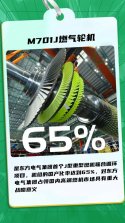Historically, gas turbine frame types were defined by output, firing temperatures and pressure ratio. As advances were made in materials and cooling technologies, gas turbines were able to fire hotter, resulting in better efficiencies and higher outputs. Design changes in the compressor and turbine section were commonly needed, and thus when a manufacturer made improvements significant enough to increase output and efficiency, a new turbine class was born. Although at times the nomenclature became murkier, as evidenced by technologies called “F-class” that featured firing temperature, output, efficiency, and design in line with advanced technology, today’s HDGT classes can be broadly categorized into three areas based on OEM gas turbine product names, size, and efficiency. Focusing on size, D- and E- class engines are typically in the 75 – 110 MW range. Products include GE’s 7E.03, Siemens SGT6-2000E, and Mitsubishi Hitachi’s H-100. F-class turbines are typically in the 170-230 MW range. Products include GE’s 7F.03-.05 models, Siemen’s SGT6-5000F, and Mitsubishi Hitachi’s M501F. Lastly, the advanced class turbines (G-, H-, and J- frames) are typically in the 275 – 350 MW range. These include Mitsubishi Hitachi’s M501J and M501G machines, Siemens SGT6-8000H, and GE’s 7HA.01 and .02 models.

